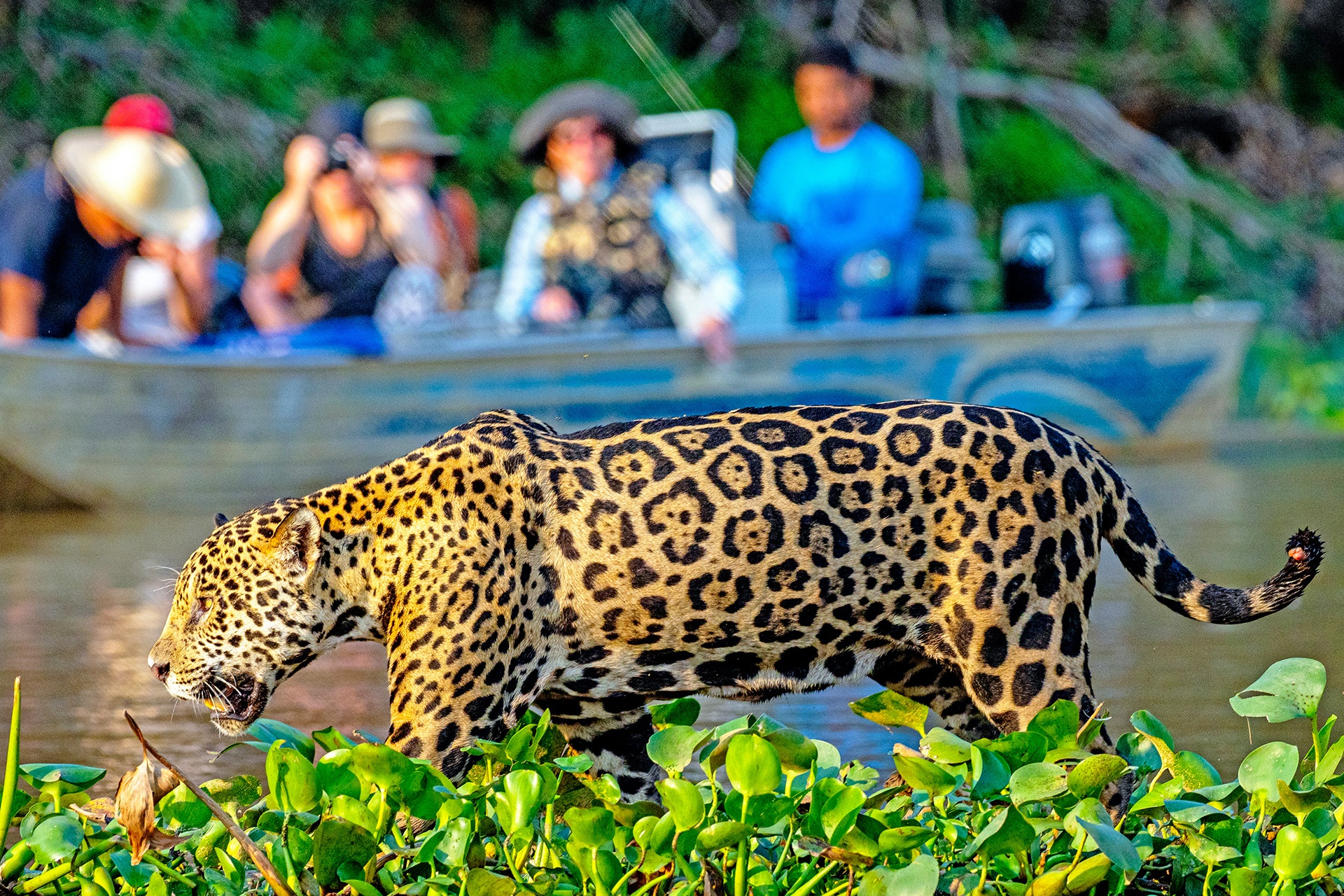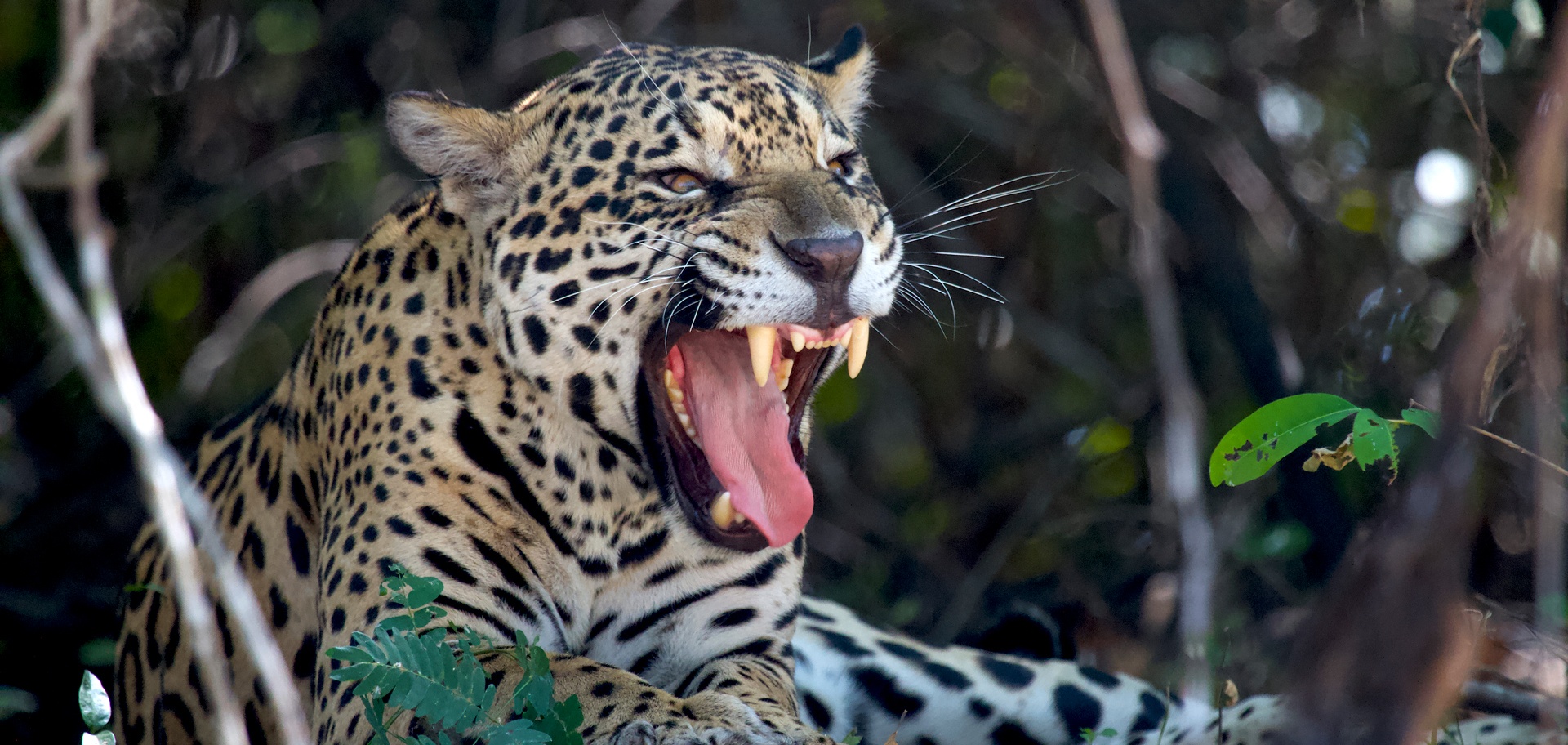It was in the early morning when we first spotted Aracy, positioned near a small waterhole in Brazil’s southern Pantanal region. We followed her through the grasslands, watching the jaguar meander among trees and along the occasional dirt pathway—at one point, even walking within several feet of our open-sided 4×4 vehicle—until she spotted a herd of capybaras grazing beside a lake. “Keep quiet,” our guide Lucas whispered. “She’s about to make her move.”
In an instant, the capybaras were running into the water with Aracy sprinting behind them, hoping for an early day feast. Although luck wasn’t on her side this round, the enormous feline put on a show for the ages.
Wildlife is a given in Brazil’s massive Pantanal, a more than 75,000 square-mile UNESCO Biosphere Reserve that’s home to the largest tropical wetlands and flooded grasslands on the planet. Everything from squadrons of peccaries (hoofed mammals that resemble pigs) to alligator-like caiman call this incredible natural region—one that stretches across portions of Brazil, Bolivia and Paraguay, covering an area that’s equivalent to the size of Belgium, Holland, Portugal and Switzerland combined—home. In fact, the Pantanal hosts South America’s densest concentration of wildlife: we’re talking animals as varied as giant anteaters, musk deer, tapir and blue-and-yellow colored hyacinth macaws. Impressive, since many visitors flock to the continent’s other fauna-filled destinations, like the Amazon rainforest, without knowing that these wetlands exist.
These days, however, the Pantanal is gaining traction among wildlife lovers, thanks in large part to the efforts of Onçafari, a project established to promote conservation through ecotourism, mainly habituating jaguars to safari vehicles with the notion that the more people see these stealth cats in the wild, the more they’ll likely do something to save them.

© Cassiano “Zapa” Zaniboni
Onçafari and the Pantanal’s Jaguar Population
Former Formula 1 racing driver Mario Haberfeld established Onçafari in August 2011. Its name is a combination of “onça,” the Portuguese word for jaguar, and “safari,” which means journey in Swahili. Haberfeld was inspired to start the project after visiting the African continent, where wildlife such as lions, elephants, and hyenas have grown up around safari vehicles. The Brazil native wanted to bring the same type of ecotourism to the Pantanal, helping to preserve its biodiversity in the process. Although the organization also works with other species ranging from giant otters to crab-eating foxes, in the Pantanal, it’s the jaguars that draw the most attention.
Jaguars are similar to leopards, their African counterparts, though they’re stockier than leopards and more muscular. Each one is also highly unique. Some are more golden in color than others, their whiskers longer or shorter, and their faces narrower or fuller. Historically, their range stretches from Argentina north up to Arizona’s Grand Canyon, though their population has decreased by 25% in just over two decades, spurred in large part by deforestation and illegal logging. Today, jaguars occupy less than half of where they once roamed, with sightings only as far north as Mexico’s Sonora state and occasionally crossing the border into Arizona. Seeing one in the wild has long been a remarkably rare experience.
Lucas Morgado is an Onçafari biologist who is well-versed in tracking wildlife. He’s also our safari guide in Brazil’s southern Pantanal. He tells us the story behind Aracy. How she was born back in 2020 and has been in the proximity of vehicles all of her life. She’s the daughter of Isa, one of the first two jaguars to be reintroduced by Onçafari to the Pantanal after losing her mother at a young age. And that she’s missing the tip of her left ear. We also learn about jaguars in general: things like their having the strongest bite of all cats—even lions and tigers—how the rosette patterns on their fur are as unique as human fingerprints, and while they’re typically solitary creatures, these elusive cats sometimes form coalitions to survive.

©Helder Brandao de Oliveira
Caiman Ecological Refuge
Of the estimated 15,000 to 64,000 jaguars remaining in the wild, more than half of them live within the Amazon Rainforest and the Pantanal. About 60 to 80 jaguars of these reside inside the 204-square-mile Caiman Ecological Refuge, a renowned private reserve that happens to be the site of our spacious lodge, as well as Pantanal’s Onçafari jaguar team and scientific research center. Here, the project’s team members are constantly evaluating the health of the felines and monitoring their behavior through motion sensor cameras, direct observation, and a handful of GPS-equipped radio collars that can map their locations through different frequencies. But of the five jaguars that we end up spotting over the course of two days (with names like Timbo, Aroeira, Hades and Flor), only one of them has been collared to provide Onçafari with its coordinates. The other sightings are merely a testament to how well the jaguar habituation program is working.
According to Onçafari, only 16% of guests at the Caiman Ecological Refuge reported seeing jaguars in 2013. Ten years later, the percentage was 100. Although Onçafari never guarantees a sighting, the likelihood of spotting a jaguar (or jaguars) here really is possibly the best on the planet.
After about 40 minutes in Aracy’s presence, it’s time to move on. But before starting up our 4×4 vehicle’s engine, Morgado clears his throat. It’s a way to indicate to the felines that there’s a louder sound coming and remind these big cats that they can keep on keeping on without ever feeling threatened.
Tracking Jaguars with Nat Hab
Natural Habitat Adventures’ Jaguars & Wildlife of Brazil’s Pantanal includes a few nights lodging at the Caiman Ecological Refuge and time spent with the Onçafari Jaguar Project, as well as one of the reserve’s spectacular Pantaneiro cowboy dinners—complete with an array of spit-roasted meat. Participants also have an opportunity to spot jaguars in the northern Pantanal and see other species like toucans, howler monkeys, giant armadillos and big-headed swamp turtles. Want to make your experience even more amazing? Tack on a trip extension to see one of the world’s mightiest waterfalls, the more-than-mile-long Iguazu Falls, straddling the border between Brazil and Argentina.
The post Tracking Jaguars with the Onçafari Project: Conservation Travel in Brazil’s Pantanal first appeared on Good Nature Travel Blog.